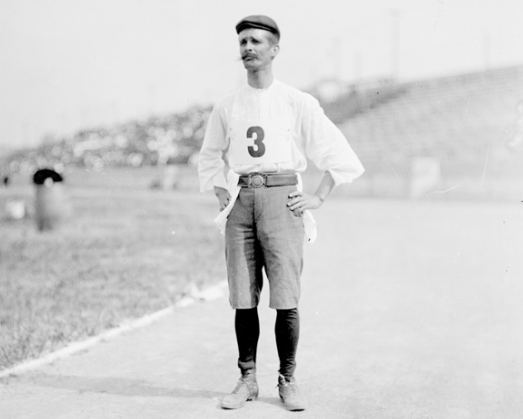
***
For the first several Olympics, there weren’t any clothing requirements for athletes. At that time, the Olympics were not yet considered a nationalistic competition among countries but of amateur athletes competing against each other. According to Marathon and Beyond, “Many of these athletes were sponsored by athletic clubs or colleges, but often the Olympic hopefuls had to pay their own way to the Games. The complications of arranging and financing such a long trip no doubt kept many good athletes away from the St. Louis Games.”
One marathon runner in the St Louis Olympic Games by the name of Felix Carvajal, a 5’1″ postman from Cuba, showed up late for the race start in his regular trousers, everyday shirt with long sleeves, and heavy walking shoes. En route to the Games, he had lost nearly all his money in a New Orleans card game. The race was delayed as a fellow competitor sheared off the bottom sections of Carvajal’s shirt sleeves and trousers.
Under a hot and humid summer day, the race field was small, mainly Americans and Greeks, and totaled just 32 starters, including two Zulu tribesman from South Africa, one of whom was barefoot. The “marathon”, which was still 24.8 miles, only had one water stop– at around the midway mark.
The first finisher, Fred Lorz of New York had pulled a Rosie Ruiz and had hitched a ride in a car for half the race after suffering from cramps. He was later disqualified (though the following year, he won the Boston marathon.)
The official winner was U.K.-born Thomas Hicks of Cambridge, Massachusetts, who somehow willed his exhausted body across the finish line in 3:28:53. To keep him going during the race, his handlers had fed him a mush of 1/60-grain strychnine sulfate and raw eggs, followed by a brandy chaser. It was all legit back then.
Our Cuban postman lacked any race support or handlers. So he snacked on apples he grabbed off a tree in a farmer’s orchard. Which of course later gave him stomach cramps and forced him to stop and rest. Yet in his heavy leather shoes and uncomfortable clothing, he managed to make it the finish in just under four hours, and which was good for fourth place. Carvajal later returned to Cuba and never ran another marathon again. –Bill Katovsky

If you happen to be in St. Louis before November 18, the Missouri History Museum has an exhibit of photographs featuring competitors from the 1904 Olympics. One of the photos is of the two Zulu warriors mentioned in Bill’s article, one wearing shoes and the other without. Here is the site address:
http://www.mohistory.org/node/7518